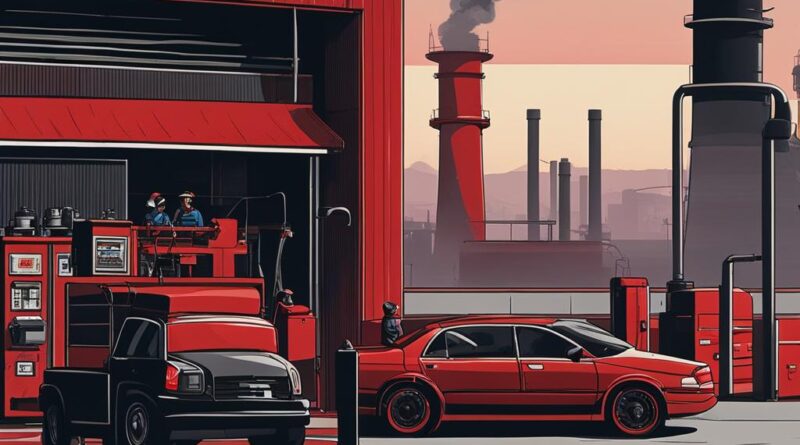Smog Check History: Understand Your Car’s Emission Journey
Curious about the history of smog checks for your vehicle? Understanding the journey of your car’s emissions can provide valuable insights into its maintenance, performance, and compliance with emission standards. In this article, we will delve into the smog check history, records, and test procedures, shedding light on the importance of these evaluations for both vehicle owners and buyers.
Key Takeaways:
- Smog check history provides valuable information about a vehicle’s emissions performance.
- Roadside surveys play a vital role in assessing emissions and improving the Smog Check Program.
- Verifying smog check results independently is crucial when buying a used car.
- Regular smog check inspections ensure compliance with emission standards and proper functioning of emission control equipment.
- Participating in roadside surveys contributes to air quality improvement efforts.
Importance of Roadside Surveys in Smog Check History
Roadside surveys play a vital role in assessing the emissions emitted by vehicles on California roads. The data collected helps ensure compliance with federal standards for reducing ozone-forming pollution from motor vehicles. The surveys also provide valuable information for evaluating and improving the performance of the Smog Check Program.
The surveys are conducted in areas where air quality issues exist, and ZIP codes are randomly selected for surveying. The survey process is similar to a Smog Check inspection and takes less than 10 minutes per vehicle. Participants receive a Vehicle Inspection Report (VIR) detailing the survey results, and any observed mechanical issues are also reported to the participants.
To illustrate the importance of roadside surveys, consider the following table that compares emission test results from roadside surveys with those from licensed Smog Check stations:
| Emission Test Results | Roadside Surveys | Licensed Smog Check Stations |
|---|---|---|
| Passed | 78% | 85% |
| Failed | 22% | 15% |
As shown in the table, roadside surveys reveal a higher percentage of failed emission tests compared to licensed Smog Check stations. This highlights the importance of conducting these surveys to identify vehicles that may be emitting excessive pollutants, thus contributing to air pollution and the degradation of air quality.
Smog Check Requirements for Vehicle Sales and Transfers
When selling or transferring a vehicle in California, it is important to understand the smog check requirements set by the California Department of Motor Vehicles (DMV). These requirements are in place to ensure that buyers are protected and that vehicles meet the necessary emission standards. A valid smog check certificate is a crucial document that the seller must provide to the buyer.
The smog check certificate must be obtained within 90 days before the sale or transfer of the vehicle. The seller is responsible for obtaining this certificate, which is obtained through a smog check inspection at a licensed smog check station. The certificate serves as proof that the vehicle has passed the required emissions tests and is compliant with the state’s emission standards.
The California DMV mandates this smog check requirement to prevent buyers from purchasing vehicles that may not pass a smog check. However, there are exceptions to this requirement. For example, if the vehicle is being sold to a licensed dismantler, a family member, or if a biennial smog certification was submitted within the previous 90 days, a smog check may not be necessary.
| Smog Check Requirements for Vehicle Sales and Transfers | Exceptions |
|---|---|
| A valid smog check certificate must be obtained within 90 days before the sale or transfer of the vehicle. | – Sales to licensed dismantlers – Sales to family members – A biennial smog certification was submitted in the previous 90 days |
It is crucial for buyers to verify the smog check results independently to ensure the accuracy and validity of the certificate. The California DMV provides a Vehicle Emissions System Statement that should be furnished by the seller if a transfer application is submitted within 90 days of a valid smog certification. This statement emphasizes the buyer’s right to have the vehicle tested independently to ensure compliance with the state’s emissions standards. If the vehicle fails the test, the seller is obligated to reimburse the buyer for the cost of the test and must have the vehicle repaired to meet the specified emissions standards before completing the transaction.
Importance of Verifying Smog Check Results
When purchasing a used car, it is crucial to verify the results of the last smog inspection independently. This is an important step to ensure that the vehicle is in compliance with emissions standards and does not pose any hidden issues. The California Department of Motor Vehicles provides a Vehicle Emissions System Statement that should be furnished by the seller if a transfer application is submitted within 90 days of a valid smog certification. This statement emphasizes the buyer’s right to have the vehicle tested independently to ensure compliance.
Verifying the smog check results is necessary to avoid any potential surprises or costly repairs down the line. If the vehicle fails the independent test, the seller is obligated to reimburse the buyer for the cost of the test and must have the vehicle repaired to meet the specified emissions standards before completing the transaction. This process ensures that buyers are protected and provides them with confidence in their purchase.
By independently verifying the smog check results, buyers can have peace of mind knowing that the vehicle they are purchasing is not only compliant with emissions standards but also in good overall condition. It is an essential step in protecting oneself when buying a used car and making a wise investment.
The Importance of Independent Verification:
When it comes to buying a used car, independent verification of the smog check results is crucial. This step helps buyers ensure that the vehicle they are purchasing is compliant with emissions standards and in good overall condition. By obtaining an independent smog check, buyers can have the confidence of knowing they are making a wise investment and avoiding potential future issues.
Ensuring that the results of the last smog inspection are accurate and verified independently is an essential part of the car-buying process. Buyers should review the Vehicle Emissions System Statement provided by the seller and exercise their right to have the vehicle tested independently if necessary. By taking these steps, buyers can protect themselves and make informed decisions when purchasing a used car.
Checking the Smog Check History of a Vehicle
When considering the purchase of a used car, it is essential to gather as much information as possible to make an informed decision. One crucial aspect to consider is the smog check history of the vehicle. By checking the smog check history, you can gain valuable insights into the vehicle’s emission journey and any potential issues it may have had in the past.
The smog check history of vehicles inspected under the California Smog Check Program is available online. This history provides a comprehensive record of the vehicle’s past smog inspections, including the results and any issues identified. To access the smog check history, you can use either the vehicle identification number (VIN) or the license plate number on the Smog Check Program website. This allows you to review the results of past smog inspections and identify any recurring patterns of failed inspections, which could be indicative of persistent emission problems.
By checking the smog check history, you can make a more informed decision about the purchase of a used car. It allows you to assess the vehicle’s compliance with emission standards, its overall condition, and any potential issues that may need to be addressed. Additionally, it provides peace of mind knowing that you have thoroughly reviewed the vehicle’s emission journey before making a significant investment.
| Benefits of Checking Smog Check History | How to Check Smog Check History |
|---|---|
|
|
“Checking the smog check history provides valuable information about a vehicle’s emission journey and can help buyers make an informed decision.”

Protecting Yourself When Buying a Used Car
When it comes to purchasing a used car, safeguarding your investment is crucial. Understanding the vehicle’s history and conducting thorough inspections can help you make an informed decision. Here are some essential steps to take when buying a used car:
1. Check the Vehicle’s Smog Check History
One of the key factors to consider is the vehicle’s smog check history. This history provides valuable information about the vehicle’s emissions journey and can indicate any recurring issues. By checking the smog check history using the vehicle identification number (VIN) or license plate number on the Smog Check Program website, you can ensure that the vehicle has passed a valid smog inspection within the last 90 days.
2. Request a Completed Vehicle Emissions System Statement
To further protect yourself, request a completed Vehicle Emissions System Statement from the seller. This statement emphasizes your right to have the vehicle independently tested to ensure compliance with emissions standards. By exercising this right, you can verify the vehicle’s emission status and identify any potential problems before making the purchase.
3. Have the Vehicle Inspected by Certified Professionals
Lastly, it is crucial to have the vehicle inspected by dedicated STAR certified professionals. These experts can provide a comprehensive assessment of the vehicle’s condition, including its emissions performance. By getting a professional inspection, you can identify any hidden issues and make a more informed decision about the purchase.
By following these steps and prioritizing your due diligence, you can protect yourself when buying a used car. By checking the smog check history, requesting a Vehicle Emissions System Statement, and having the vehicle inspected by certified professionals, you can ensure that your investment is reliable, compliant with emission standards, and in good condition.
The Role of Emissions Problems in Vehicle Performance
Emissions problems in vehicles can have a significant impact on both fuel economy and driveability. Today’s vehicles are complex systems where emissions-related issues are often intertwined with overall performance. By addressing emissions problems, potential fuel efficiency and drivability issues can also be improved. Therefore, addressing emissions problems is not only beneficial for environmental reasons but also for the overall performance and longevity of the vehicle.
According to a study conducted by the Environmental Protection Agency (EPA), vehicles with malfunctioning emission control systems can experience reduced fuel economy by up to 40%. This is because the engine may not be operating at its optimal efficiency, leading to excessive fuel consumption. Additionally, emissions problems can also affect the engine’s combustion process, resulting in decreased power and acceleration.
Furthermore, emissions problems can lead to decreased engine performance and reliability. For example, a malfunctioning oxygen sensor can cause the engine to run too rich or too lean, resulting in increased emissions and potential damage to the catalytic converter. Inefficient combustion can also lead to the buildup of carbon deposits on engine components, affecting their performance and lifespan. By addressing emissions problems promptly, vehicle owners can prevent further damage to the engine and ensure optimal performance.
It is important to note that emissions problems can also impact the vehicle’s onboard diagnostic system, which monitors various systems and components for proper functioning. If the system detects a fault related to emissions, it may trigger the “check engine” light, indicating the need for immediate attention. Ignoring these warnings can lead to more extensive and costly repairs down the line.
| Emissions Problems | Effects on Vehicle Performance |
|---|---|
| Malfunctioning oxygen sensor | Decreased fuel efficiency, reduced power |
| Faulty catalytic converter | Increased emissions, potential engine damage |
| Carbon buildup on engine components | Poor engine performance, decreased reliability |

In conclusion, addressing emissions problems in vehicles is essential for maintaining optimal fuel economy, driveability, and overall performance. By promptly addressing and resolving these issues, vehicle owners can not only contribute to a cleaner environment but also ensure the longevity and reliability of their vehicles. Regular maintenance, including routine smog check inspections, can help detect and address emissions-related problems before they become more severe. By staying proactive, vehicle owners can experience improved fuel efficiency, better engine performance, and a smoother driving experience.
The Importance of Regular Smog Check Inspections
Regular smog check inspections are vital for vehicle owners to maintain compliance with emission standards and ensure the proper functioning of their vehicles’ emission control equipment. These inspections play a crucial role in identifying and addressing any issues or malfunctions that may be affecting the vehicle’s emissions and overall performance.
By staying up to date with regular smog check inspections, vehicle owners can be proactive in addressing any potential problems related to emissions. This not only contributes to better air quality but also helps to maintain the longevity and reliability of the vehicle.
In California, where smog check requirements are strict, regular inspections are particularly important. The state has set emission standards to reduce pollution from motor vehicles, and compliance with these standards is necessary to ensure the well-being of both the environment and public health.
| Benefits of Regular Smog Check Inspections |
|---|
| 1. Compliance with emission standards |
| 2. Identification and resolution of emission-related issues |
| 3. Improved air quality |
| 4. Enhanced vehicle performance and longevity |
By following the recommended schedule for smog check inspections and promptly addressing any necessary repairs or maintenance, vehicle owners can ensure that their vehicles are in compliance with applicable laws, contribute to better air quality, and avoid potential penalties.
The Benefits of Participating in Roadside Surveys
Participating in roadside surveys for smog check purposes can contribute to air quality improvement efforts. By voluntarily participating in these surveys, vehicle owners play a crucial role in helping to evaluate and improve the performance of the Smog Check Program. The data collected from these surveys helps identify potential areas for improvement and ensures that California meets federal standards for reducing pollution generated by motor vehicles.
These surveys provide important insights into the emissions emitted by vehicles on California roads. By participating, vehicle owners contribute valuable data that helps regulators and policymakers make informed decisions about emissions control and air quality management strategies. The information collected can also be used to evaluate and refine the effectiveness of the Smog Check Program, ensuring that it continues to meet its goals of reducing ozone-forming pollution from motor vehicles.
Additionally, participating in roadside surveys allows vehicle owners to contribute to the overall improvement of air quality in their communities. By actively taking part in these surveys, individuals show their commitment to reducing pollution and protecting the environment. This collective effort has a significant impact on creating cleaner air for everyone to breathe, contributing to a healthier and more sustainable future.

“Participating in roadside surveys for smog check purposes can contribute to air quality improvement efforts.”
In summary, participating in roadside surveys is not only beneficial for individual vehicle owners but also for the greater community. It helps evaluate and improve the performance of the Smog Check Program, ensures compliance with federal emissions standards, and contributes to air quality improvement. By actively participating in these surveys, individuals can make a positive impact on the environment and create a healthier future for themselves and others.
Relevance of Roadside Surveys to Smog Check Program Evaluation
Roadside surveys play a crucial role in evaluating the effectiveness of the Smog Check Program and ensuring compliance with emission standards. The data collected from these surveys provides valuable insights that contribute to the overall evaluation and improvement of the program. By comparing the emissions information obtained from roadside surveys with the results from licensed Smog Check stations, regulators can identify any discrepancies and make necessary adjustments to enhance the program’s performance.
One of the key benefits of roadside surveys is the comprehensive data they provide. These surveys cover various areas with high vehicle populations and air quality issues, offering a representative snapshot of the emission levels on California roads. The participation of ASE-certified automotive technicians adds credibility to the survey results, ensuring accuracy and reliability.
The collected data helps regulators understand the current state of vehicle emissions in different regions and assess the program’s effectiveness in reducing pollution. It also enables policymakers to identify trends, patterns, and areas for improvement. By analyzing the survey data, regulators can develop targeted strategies and policies, promoting better air quality and a healthier environment for Californians.
Benefits of Roadside Surveys:
- Comprehensive data collection from high vehicle population areas
- Evaluation and improvement of the Smog Check Program
- Identification of discrepancies and adjustments to enhance program performance
- Assessment of current emission levels and trends
- Development of targeted strategies and policies for better air quality
Participation in roadside surveys is crucial for maintaining the effectiveness of the Smog Check Program and ensuring compliance with emission standards. By participating voluntarily, vehicle owners contribute to the evaluation and improvement of the program, helping California meet federal standards for reducing pollution generated by motor vehicles.

| Roadside Survey Data | Benefits |
|---|---|
| Comprehensive and representative data | Provides a snapshot of emission levels on California roads |
| Accurate and reliable results | Conducted by ASE-certified automotive technicians |
| Program evaluation and improvement | Identifies areas for enhancement and policy adjustments |
| Identification of trends and patterns | Helps develop targeted strategies for better air quality |
Conclusion
In conclusion, understanding the smog check history of a vehicle is essential for vehicle owners and buyers alike. By reviewing the vehicle’s emission journey, including past smog check results and participating in roadside surveys, individuals can make informed decisions about their vehicle’s maintenance, performance, and compliance with emission standards.
Regular smog check inspections, independent verification of results, and thorough vehicle inspections contribute not only to environmental protection but also to the overall longevity and reliability of a vehicle. By staying up to date with smog check requirements and ensuring compliance, vehicle owners can contribute to better air quality and avoid potential penalties.
It is also important for buyers to protect themselves when purchasing a used car. By checking the vehicle’s smog check history and requesting a completed Vehicle Emissions System Statement, buyers can verify the vehicle’s compliance with emissions standards and have the vehicle independently tested if necessary.
Overall, staying informed about smog check history, participating in emission tests and inspections, and taking proactive measures ensure that vehicles are in compliance with emission standards, contribute to better air quality, and promote the longevity and reliability of vehicles.
FAQ
What is the purpose of the Roadside Inspection Program?
The Roadside Inspection Program collects emissions information from vehicles in California to evaluate the effectiveness of the Smog Check Program and ensure compliance with federal emission standards.
Where are roadside surveys conducted?
Roadside surveys are conducted in areas with high vehicle populations and air quality issues, such as the Central Valley, San Francisco Bay area, Los Angeles area, Inland Empire, and San Diego.
Who performs the roadside surveys?
The surveys are performed by BAR representatives who are ASE-certified automotive technicians.
Is participation in the survey mandatory?
No, participation in the survey is voluntary, and there are no consequences for consumers.
Is a roadside survey a replacement for a regular Smog Check inspection?
No, the survey does not replace a regular Smog Check inspection.
What is the purpose of smog inspection certification when selling or transferring a vehicle?
The certification is required to protect buyers from purchasing vehicles that won’t pass a smog check and must be obtained within 90 days before the sale or transfer.
Are there exceptions to the smog inspection certification requirement?
Yes, exceptions include sales to licensed dismantlers, family members, or if a biennial smog certification was submitted within 90 days prior to the transfer.
How can buyers verify the results of the last smog inspection?
Buyers can request a Vehicle Emissions System Statement from the seller and have the vehicle independently tested for compliance with emissions standards.
How can individuals check the smog check history of a vehicle?
Individuals can check the smog check history using the vehicle identification number (VIN) or license plate number on the Smog Check Program website.
Why is it important to protect yourself when buying a used car?
Protecting yourself when buying a used car involves checking the smog check history, requesting a Vehicle Emissions System Statement, and having the vehicle inspected by certified professionals.
What is the role of emissions problems in vehicle performance?
Emissions problems can have a significant impact on both fuel economy and driveability, as they are often intertwined with overall performance.
Why are regular smog check inspections important?
Regular smog check inspections help maintain compliance with emission standards, identify any issues affecting emissions and performance, and avoid penalties.
How do roadside surveys contribute to air quality improvement?
Voluntarily participating in roadside surveys helps evaluate and improve the performance of the Smog Check Program, ensuring compliance with federal standards for reducing pollution from motor vehicles.
How do roadside surveys help evaluate the effectiveness of the Smog Check Program?
Roadside surveys provide valuable data for comparing emissions information from motor vehicles with results from licensed Smog Check stations, identifying areas for improvement and ensuring compliance with emission standards.

